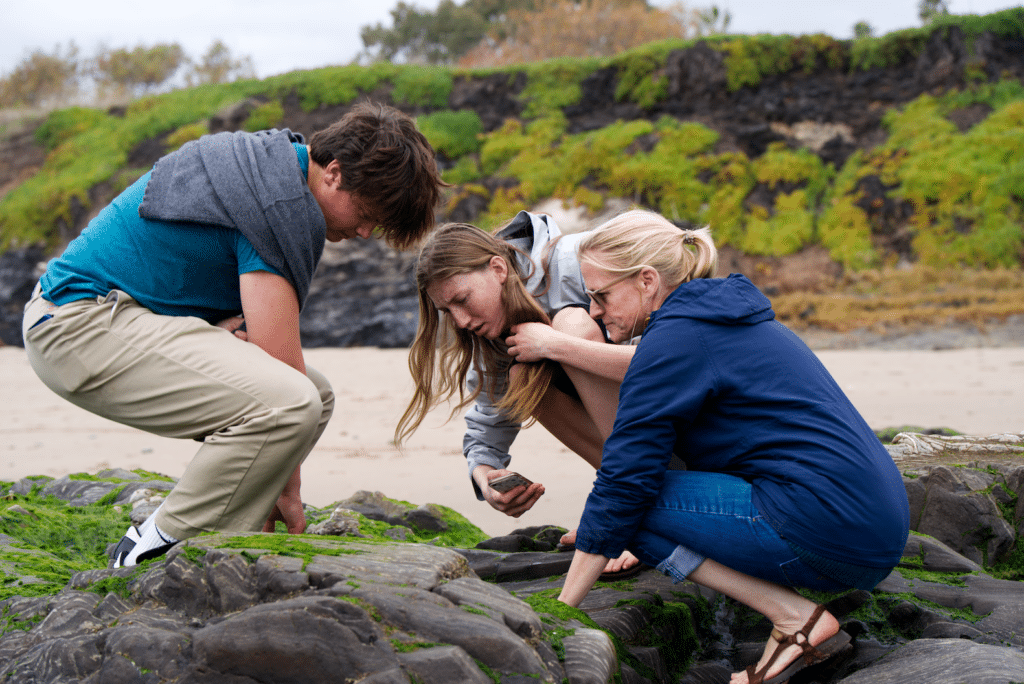Teaching Tidepools
By Leslie Turnbull ’85
Beth Caylor doesn’t necessarily have first-century Stoic educational philosophy on her mind all the time – certainly not on a rare morning off from her many responsibilities as a Cate faculty member and dorm parent. Beth loves teaching, of course. The way she lights up when she talks about her students is evidence of that. However, like the rest of us, Beth also appreciates her personal time, and, like many of us, when she has that time, she loves going to the beach. The same lifelong passion for nature in general – and the sea in particular – that led this Cate faculty member to take a masters degree in marine science (in addition to her M.S. in science education and curriculum studies) also consistently calls her to the water’s edge.
While Beth’s science teaching career has taken her to some pretty incredible seaside locations (the Bahamas, Hawaii, and aboard the SSV Ocean Star educational vessel in the Caribbean Sea), she is just as delighted to call Carpinteria, California “home” these days. Now married and with a young family, Beth feels the emotional pull of the shoreline whenever low tides expose the rocky reefs and pools just beyond Carpinteria’s famous beaches. She especially enjoys taking her young son on these exploratory adventures; “tidepooling” is an opportunity to share her own interest in sea life with her family while also demonstrating how to safely interact with the marine environment without disturbing it.
Life doesn’t happen in silos, however, and it was during one such family trip that Beth-the-mom suddenly handed Beth-the-teacher a revelation. After attracting the attention of other curious visitors to the tidepools – people who peppered her with questions and observations of their own – Beth found herself wishing she had other marine biologists with her to help her respond to other people’s curiosity.
“And then it occurred to me!” Beth exclaims. “I knew 26 other budding scientists who would be great seaside ambassadors.”
Beth is referring, of course, to the seniors enrolled in her Coastal and Marine Ecology elective on the Mesa. After following Cate’s carefully constructed science curriculum through required ninth-grade Physics and subsequent inquiry-based studies of biology and chemistry, motivated students may choose to follow Beth’s path into a deeper focus on the Earth’s nexus between land and sea and beyond into the deep blue of the Ocean itself.
Coastal and Marine Ecology is a rigorous, college-level biology course, one in which students read primary scientific literature and begin inquiry-based research. Fieldwork is a required component of the course because as a scientist herself, Beth Caylor knows that knowledge comes to life through hands-on experience. Several weeks into the course, Beth knows her students are knowledgeable, thoughtful marine scientists in their own rights. They have conducted research of their own in the tidepools. They are also a group of individuals, with unique talents and motivations they are learning to use collaboratively.
Would the opportunity to share the knowledge they were gaining through their own studies with others be a useful way for her students to solidify that knowledge and practice their own presentation skills, both group and individual? Standing on the beach that day, Beth certainly thought so. As she now says:
“When you’re looking at tidepools, in an active marine environment, you have to be there … be present, and observant. That’s the whole point of inquiry-based learning, to make students more active and less passive; passive acceptance of knowledge makes it less ‘sticky.’ I know from reading their reflections that my students have achieved active, useful learning. They are very capable of transmitting that to others.”
Given Cate’s symbiotic relationship with the local township and its people, she also thought Cate volunteerism at the shoreline would be an excellent opportunity to practice Servons.
Beth quickly sprung into action. Checking tidal calendars, she identified periods of low tide that would coincide with days and times that her students might be free from other Mesa commitments. She got the news out to Carpinteria Unified School District to share with their own elementary and middle-school families: Cate students, decked in blue and identified by School banners, would be on hand at the tidepools on certain days and at certain times to unpack the wonders of the complex ecosystem right on their own shoreline.
Things were no less busy back in the classroom. Beth’s students, highly enthusiastic about her idea, also grasped the responsibility of it: if they were going to be teaching others about sea life, the marine ecosystem, and sustainable ways of interacting with the environment, they would need to hone their own scientific game to perfection. It wasn’t just enough to know things – what characteristics might identify which mollusk, for example. Ms. Caylor’s class needed to be able to share that knowledge in ways that would be accessible and engaging to a targeted audience of younger students and their interested families. Young children, especially, need to know how an organism and its role in the environment relate back to them in order to feel its relevance. Beth’s students embraced the challenge of making those connections.
“They were so motivated,” Beth recalls. “I asked each student what they thought they could bring to the experience. Some more gregarious types were eager to do the talking. Others wanted to plan and structure the experience for maximum success. The artists in the group volunteered to prepare visual and tactile aids. The goal wasn’t just to do this, but to do this well through collaboration. The ability to collaborate is another important metric of success for the practicing scientist.”
The Coastal and Marine Ecology students were right on board – even up to the time the class went down to the beach for their first educational session. This was when Beth became especially aware of how the experience allowed each student to successfully engage with the subject in the ways that suited their own learning styles best.
“One highly energetic student went racing off into the intertidal zone. He was determined to find an octopus he could show the children and get them excited! Another girl, one who is highly focused, had her magnifying glass out and was right up close on the rocks, ready to identify anything and explain how it fit in the overall system of the shoreline.”
As a highly experienced educator, Beth knows the value of this individualisation; a student allowed not just to teach their subject but also to partner with others so that each may teach to their strengths is not only mastering knowledge but also the skills needed to apply and enhance that knowledge.
The Cate class’ day at the beach was a resounding success. The numerous families moving through the two-and-a-half hour demonstration period enthused about the experience, and asked eagerly when another might be planned. The students, reflecting after the fact, recalled experiences both general and specific they felt would stay with them through the rest of their careers.
“‘Impactful,’ ‘meaningful,’ and ‘inspiring’ are words that came up again and again in student reflections,” Beth recounts. As their teacher, she is gratified. “I know my students can all ‘pass tests.’ But seeing them able to convey their knowledge effectively shows me they are truly mastering science.”
In this, Beth Caylor echoes other scientists from Einstein to Oppenheimer to Feynman. Each of these “greats,” has, in their own way, expressed some version of Seneca’s original thought: In order to learn, teach.
More educational days at the beach are planned for this trimester, and Beth Caylor intends to keep the practice as part of her advanced class curriculum. Those interested in the dates and times are encouraged to contact her at beth_caylor@cate.org.

